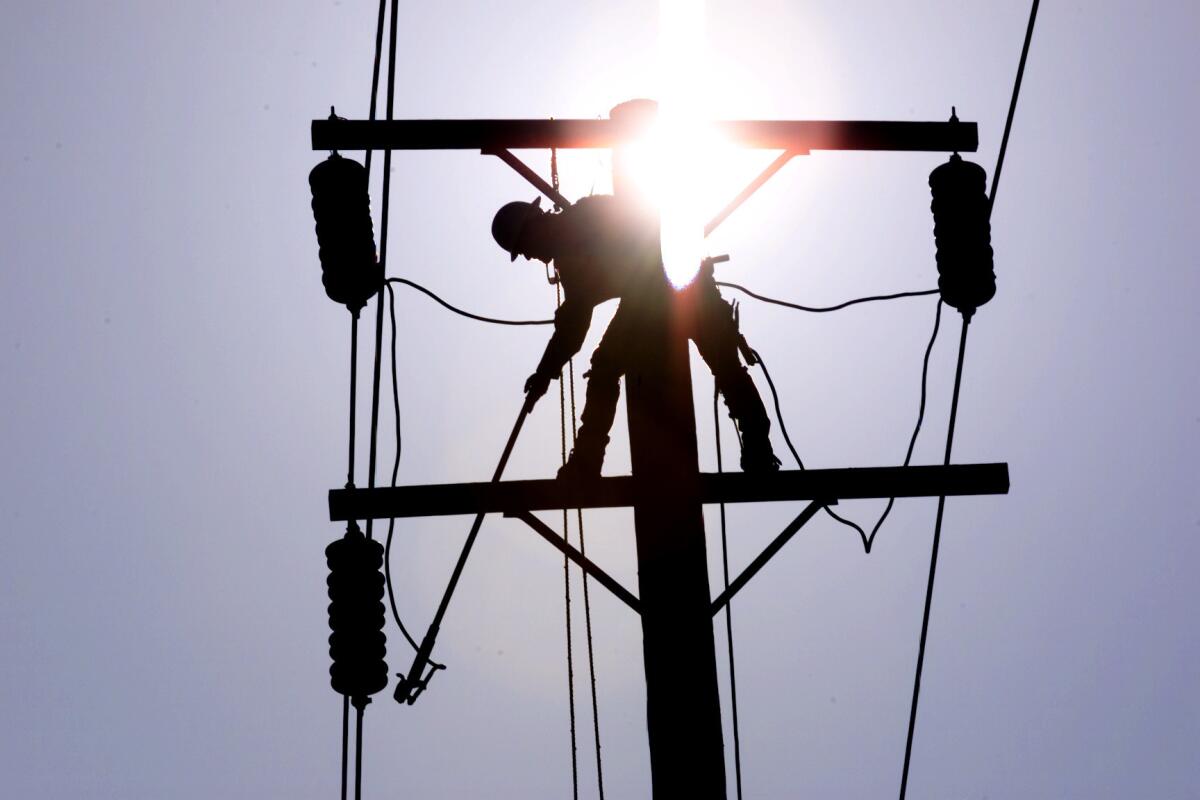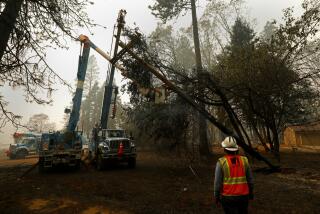Power shut-offs could prevent wildfires, but at what cost to the elderly and disabled?

Cecilia Santillano faced a difficult decision last year before the power went out in her Simi Valley neighborhood: Ignore her monthly bills and buy a generator, or hope the batteries on her husband’s ventilators would outlast the next outage.
“If I didn’t have the generator and there was no power and no sign of it getting turned on, George could start passing away,” said Santillano, whose husband suffers from a rare autoimmune disease and is bound to a wheelchair. “They are expensive and I didn’t want to buy it, but I’d rather be safe.”
The power outage Santillano endured wasn’t related to preventing wildfires — she said it was caused by Southern California Edison maintenance. But outages like hers could become more commonplace and prolonged as California utility companies expand their use of intentional electricity shut-offs to prevent power lines from sparking wildfires.
Local leaders and public health workers fear that hundreds of thousands of vulnerable Californians, such as Santillano, could find themselves in increasingly dire situations. They also acknowledge there are wrenching trade-offs.
“This is a really tough situation,” said Karen Relucio, a public health officer in Napa County. “If they don’t shut off the power, you may have a county that catches on fire. But if they do shut off the power, you may have someone who dies because their respirator shuts off.”
Officials say the utilities have so far failed to properly warn people with accessibility issues or who depend on life-sustaining medical equipment and refrigerated medications, nor have they given public safety officials and local health services agencies enough notice prior to “public safety power shut-offs” over the last year.
Gov. Gavin Newsom vented his frustration with Pacific Gas & Electric’s handling of a shut-off in June, saying there “was no coordination and collaboration with the state.”
“They were in the office, quite literally, the next day and we had a very honest conversation about expectations,” Newsom said. “We are working to make sure this is done appropriately.”
State Sen. Mike McGuire (D-Healdsburg) called PG&E’s handling of an outage in Northern California in October “a hot mess.” The San Francisco company asked the Lake County Sheriff to sign a last-minute non-disclosure agreement in order to gain access to the company’s list of electricity dependent customers, caused a school to close that didn’t end up losing power and generally failed to communicate their plans, he said.
“PG&E was not at all prepared and they were completely disorganized,” said McGuire. “I believe they put lives at risk and we were lucky that we did not see any injuries related to those early planned power outages.”
Sumeet Singh, vice president of PG&E’s Community Wildfire Safety Program, admitted the early failures during a recent legislative hearing.
“We own it. I own it,” Singh told McGuire and other state senators. “I’m making a commitment that we’re going to do everything we can to ensure we’re satisfying the needs and the interests in regards to the information that our team really should be providing to you.”
Intentional power outages, especially those lasting a day or more, pose serious risks to some residents, particularly the elderly or those with medical issues. Respirators and other electronic medical devices can go dark. With air conditioning out, the chance of heat stroke increases. People lose food in their refrigerators, putting them at risk of accidental food poisoning.
Impaired cellular networks, traffic signals and other infrastructure problems also heighten public safety risks.
A study of a citywide New York blackout in 2003 found that total mortality increased 28 percent during the two-day event. Power outages and the exacerbation of existing medical issues were the most common causes of death related to Hurricane Irma in 2017, according to the Centers for Disease Control and Prevention.
Yet California has been plagued by repeated deadly fires in recent years, and many lawmakers view power shut-offs as a critical tool of last resort to prevent them. While officials urge the utilities to carefully scrutinize the need for shut-offs, failing to cut power in high-risk scenarios has the potential to be catastrophic.
PG&E prepared to shut off power to Butte County before the Camp fire ignited in November, but decided not to at the last minute. A transmission line sparked the blaze, the deadliest in state history, and PG&E said it would not have been included in the shut-off anyway.
During the intentional outage that affected Lake County last year, PG&E found 18 instances of wind-related damage to its equipment before the company restored power.
Conversations about turning off power to prevent wildfire began more than a decade ago. San Diego Gas & Electric asked state regulators for permission to shut off power after Santa Ana winds knocked down the company’s power lines and sparked the Witch fire in 2007, which burned nearly 200,000 acres and killed two people.
Newsom and others agree that intentional outages could be reasonable in extreme circumstances when strong winds, hot temperatures and dry vegetation create conditions that have led to some of California’s most destructive wildfires. But concerns about how the shut-offs would be carried out grew last year when Southern California Edison and PG&E announced plans to develop their own outage policies and cut power more often.
McGuire is pushing legislation that would make advanced notifications mandatory to police, fire and sheriff departments, health care facilities and telecommunication providers if their facilities will be impacted by an outage. Action is expected on his bill before the Legislature adjourns for the year next month.
Recently revised state guidelines say all customers should receive a minimum of a 24- to 48-hour notice before an outage, but state regulators acknowledge that advanced warning might not always be possible during rapid weather changes. The state has expected utilities to take extra effort to reach customers with medical and accessibility issues and ensure they have a backup plan if the outage lasts for long periods.
The utilities have been meeting with local communities around the state and some officials say PG&E’s communication has improved since last year. Edison has not proactively cut power this year and kept parts of Los Angeles and San Bernardino counties under outage warnings for nearly a month from June to July. Some critics fear Edison customers may begin to ignore the repeated warnings and find themselves unprepared when the utility triggers an outage.
Edison spokesman Brian Leventhal said the warnings are important to ensure people prepare for potential outages and the company is “continuing to fine-tune the process.”
The California Conference of Local Health Officers, a group of 61 county health officers formed in the 1970s to advise the state on public health issues, voted to send a letter to the California Public Utilities Commission raising concerns about power shut-off practices.
“My biggest concern is that we have the potential to do more harm than good,” said Andy Miller, the public health officer for Butte County. “We’d like an evaluation of that harm before we just kind of boldly go forward.”
In order to identify and warn vulnerable residents before an outage, utilities have so far relied on lists of participants in their Medical Baseline Programs, which allow people to receive discounted monthly rates if they use electricity to power life-sustaining medical equipment or motorized wheelchairs, or if they suffer from other qualifying medical issues.
Relucio said PG&E attempted to provide advanced notice to fewer than 150 Napa County residents in its Medical Baseline Program who lived within areas that lost power during outages in October and November.
Earlier this year, Relucio and her colleagues conducted their own tally of residents whose health depends on electrical equipment or who rely on refrigerated medications. The county, tapping into federal, state and local databases, discovered that PG&E’s internal list likely only covered about 10 percent of the residents who could have been at risk, Relucio said.
Elizaveta Malashenko, head of Safety and Enforcement Policy at the CPUC, agreed that the utilities rely on a “highly incomplete” accounting of residents who depend on electricity for medical issues.
She told state legislators last week that the medical baseline programs were not designed for emergency response. Residents of some mobile home parks or properties where building managers receive one electricity bill for the entire community can’t register for the programs at all.
“We had people coming to us at the fire station to get their device charged,” said Calistoga Mayor Chris Canning of the first outage in October.
PG&E Electric, Edison and SDG&E collectively serve 343,000 “medical baseline” customers, the companies said. Public health officials say the nearly 600,000 residents who receive in-home support services from the state, which provides care to elderly, blind, or disabled people who cannot fully care for themselves, should also be considered vulnerable populations that need extra help before outages.
After losing confidence in PG&E last year, Napa County worked off its own more extensive list before a shut-off in June and mapped the addresses of people using at-home medical equipment within the area that would lose power, Relucio said.
But at least one resident, a man using a device to keep his heart functioning, nearly fell through the cracks. Relucio said he only appeared on a federal list, but no phone number was listed. The county sent a sheriff’s deputy to his house to locate him.
A bill introduced by state Sen. Bill Dodd (D-Napa) would require investor-owned utilities to develop protocols to mitigate public safety impacts on medical baseline customers. It would also help some qualifying customers in high fire risk areas seek back-up generators. State regulators in June expanded the definition of at-risk communities that utilities should identify with local and state agencies to include people with developmental or physical disabilities, chronic conditions, non-English speakers, older adults and others.
The newly enacted state budget provides $75 million to statewide and local agencies for shut-off preparedness. Some say the money isn’t enough to cover the financial strain from the outages.
Roughly 6,200 residents receive some form of in-home support services in Sonoma County. Reaching out to all those people on short notice before a shut-off would be a tall order, said Paul Dunaway, director of the adult and aging division of the county’s Department of Health Services.
Dunaway said some residents cannot sustain hot and cold temperatures for prolonged periods, but might not receive any county services. Others have more basic concerns.
“We have a lot of people on food stamps or CalFresh and if they only get food resources in the beginning of the month and their food spoils, then they have to wait a significant amount of time before they are eligible for more food,” he said.
Danielle Anderson, executive director of an Independent Living Resources Center that serves people with disabilities in Ventura, Santa Barbara and San Luis Obispo counties, said her communities haven’t experienced any power shut-offs yet and are in a period she calls “the calm before the storm.” Her nonprofit has set aside $5,000 to help buy generators for people in need.
“There are a lot of individuals in our areas who do not have family support, they live on their own and barely make it. They can’t afford a generator,” Anderson said. “I hate to be the one to speak the truth that nobody wants to hear, but there are going to be deaths if this is not done the right way.”
More to Read
Start your day right
Sign up for Essential California for news, features and recommendations from the L.A. Times and beyond in your inbox six days a week.
You may occasionally receive promotional content from the Los Angeles Times.







